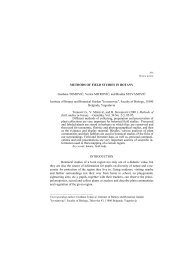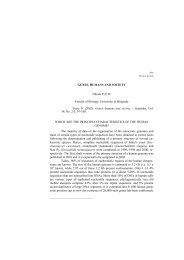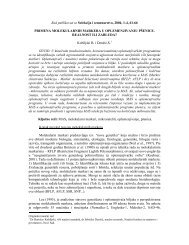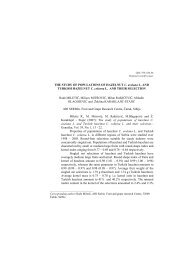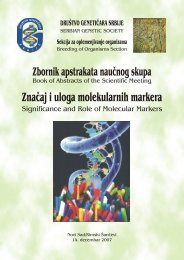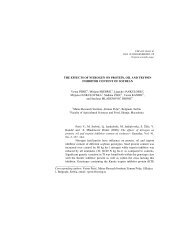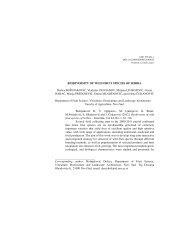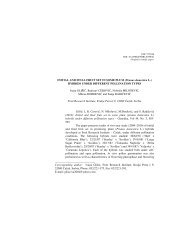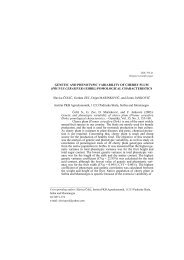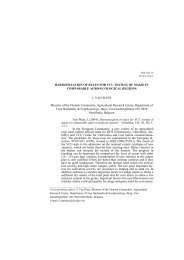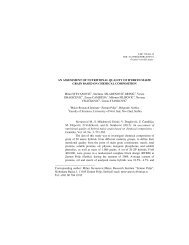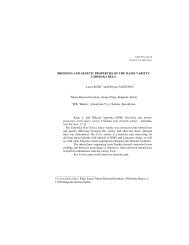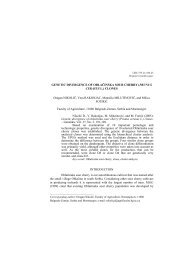Zbornik - Društvo genetičara Srbije
Zbornik - Društvo genetičara Srbije
Zbornik - Društvo genetičara Srbije
Create successful ePaper yourself
Turn your PDF publications into a flip-book with our unique Google optimized e-Paper software.
100 ZBORNIK ABSTRAKATA III KONGRESA GENETIÈARA SRBIJE IV-Usm-11<br />
Subotica, 30. novembar - 4. decembar 2004.<br />
PRIMENA MARKER ASISTIRANE SELEKCIJE (MAS) U<br />
OPLEMENJIVANJU PŠENICE U NOVOM SADU<br />
B. Kobiljski 1 , D. Obreht 2 , A. Kondiæ 1 , S. Denèiæ 1 , Lj. Vapa 2 , J. Pilipoviæ 1 ,<br />
R. Barjaktaroviæ 2 , M. Marjanoviæ 1 i M. Davidoviæ 2<br />
1<br />
Nauèni Institut za ratarstvo i povrtarstvo, Novi Sad<br />
2<br />
Prirodno-matematièki fakultet, Novi Sad<br />
U radu su analizirani rezultati dobijeni u poslednje dve godine primenom molekularnih<br />
markera – mikrosatelita, u Zavodu za strna ita, Nauènog Instituta za ratarstvo i<br />
povrtarstvo u Novom Sadu. Jedan od segmenata rada bio je detekcija alelnog<br />
polimorfizma u lokusu Rht8 gena i utvrðivanje meðuzavisnosti alelnog skora i fenotipske<br />
ekspresije vanih svojstava za oplemenjivanje pšenice (ranostasnost, visina biljke, broj i<br />
masa zrna po klasu). Drugi deo molekularne i fenotipske evaluacije odnosio se na<br />
genetsku determinaciju mirovanja semena pšenice. Deo rada sa molekularnim markerima<br />
obuhvatio je i utvrðivanje alelnog polimorfizma gluteninskih subjedinica i prisustva<br />
1B/1R translokacije kod veæeg broja genotipova pšenice iz kolekcije Zavoda. Konaèno, u<br />
radu su tumaèeni rezultati dobijeni primenom mikrosatelita u detekciji alela koji<br />
uslovljavaju tolerantnost pšenice na suvišak B. Dobijeni rezultati jasno ukazuju na se<br />
MAS sa uspehom moe primeni kao izuzetno moæna, precizna i korisna metoda u<br />
oplemenjivanju pšenice. Trenutno, najveæi znaèaj metode je, što se na osnovu dobijenih<br />
rezultata, mogu sa sigurnošæu odabrati genotipovi koji poseduju poeljne gene<br />
(sekvence) i da se, kao takvi, koriste kao roditeljske komponente u hibridizaciji. U<br />
bliskoj buduænosti, pored daljeg rada na detekciji molekularne i fenotipske varijabilnosti,<br />
primena molekularnih markera æe obuhvatiti i analizu jednog dela generacijskog<br />
materijala, kao i linija u komparativnim ogledima, kako za gore navedena svojstva, tako i<br />
za druga: otpornost na niske temperature, tolerantnost na fusarijum, zaštitu autorskih<br />
prava sorti pšenice <strong>Srbije</strong> i Crne Gore itd.<br />
APPLICATION OF MARKER-ASSISTED SELECTION (MAS) IN WHEAT<br />
BREEDING IN NOVI SAD<br />
This paper analyses the results obtained by using molecular markers – microsatellites<br />
over last two years at the Small Grains Department of Institute of Field and Vegetable<br />
Crops in Novi Sad. One part of the research was detection of allelic polymorphism at the<br />
dwarfing gene Rht8 locus and determination of relation between allelic score and<br />
phenotypic expression of traits important for wheat breeding (earliness, plant height,<br />
grain number and grain weight per spike). Another part of the molecular and phenotypic<br />
evaluations has been related to genetic determination of seed dormancy in wheat. The<br />
part of the work with molecular markers comprised the identification of allelic polymorphism<br />
of glutenin subunits and the presence of the 1B/1R translocation in genotypes from<br />
the Departmental Core Collection. Finally, the paper interprets the results obtained using<br />
microsatellites in detection of the alleles determining wheat tolerance to increased B concentration.<br />
The obtained results clearly show that MAS can be successfully applied as an<br />
extremely powerful, precise and useful method in wheat breeding. At present, the main<br />
advantage of the method is that, on the basis of its results, genotypes with desirable genes<br />
(sequences) can be determined and used as parents in hybridization. In very near future,<br />
in addition to molecular and phenotypic variability determination, application of molecular<br />
markers will be expanded to include the evaluation of segregation generations and advanced<br />
lines for both the traits mentioned above and other ones such as the tolerance to<br />
low temperatures, Fusarium, fingerprinting of wheat varieties from Serbia and<br />
Montenegro for breeders’ rights protection, etc.



